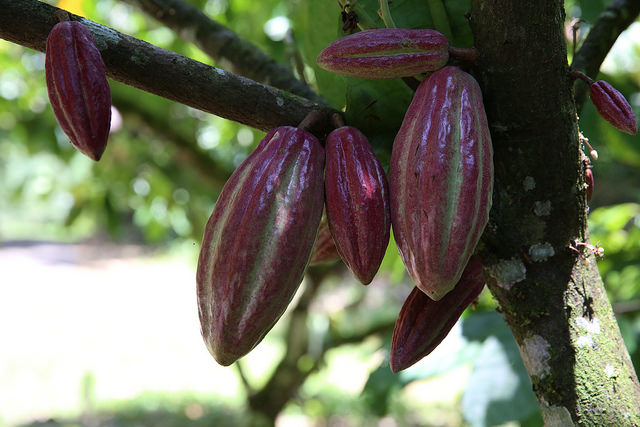Romanticizing cocoa diversity - why we should be eating diverse chocolate on Valentine's Day

As we get ready for the year's tastiest event, the Salon du Chocolat in Paris, discover our Valentine's Day special: a list of publications, podcasts and other materials that not only highlight our passion for chocolate and the people who grow and produce it, but especially diverse chocolate since the future of everyone's favorite dessert depends on the availability and sustainable use of cocoa genetic diversity.
Chocolate, one of the world's most beloved desserts that is made out of cocoa beans, takes centre stage on Valentine's Day. As we celebrate – or choose to ignore – this day, the Cocoa of Excellence Programme and the 2017 Edition of the International Cocoa Awards are in full swing with over 40 cocoa-producing countries selecting and sending their best cocoas to Bioversity International’s office in Montpellier, France.
The Cocoa of Excellence Programme – coordinated by Bioversity International and jointly organized with Event International – is the entry point for cocoa farmers to participate in the International Cocoa Awards – the only competition that recognizes their hard work and celebrates the diversity of cocoa flavours globally. This year's International Cocoa Awards will be celebrated at the Salon du Chocolat in Paris, France at the end of October.
While waiting for the year's tastiest event, discover our Valentine's Day special: a list of publications, podcasts and other materials that highlight our passion not only for chocolate and the people who grow and produce it, but especially for diverse chocolate since the future of this food depends on the availability and sustainable use of cocoa genetic diversity.
Tune into The Slow Melt - a new podcast about chocolate
Simran Sethi, food journalist and author of Bread, Wine, Chocolate: The Slow Loss of Foods We Love, a book about the story of changes in food and agriculture, has just launched the pilot of a series of podcasts that she hosts about chocolate, called The Slow Melt.
The first episode 'Chocolate is multiple' gives an overview of the different people, places and processes involved in creating chocolate – and the steps involved in savouring it. It features Brigitte Laliberté, Expert on Cacao Genetic Resources, Coordination of the Global Network for Cacao Genetic Resources and the Cocoa of Excellence Programme.
In the second episode, 'Be still my heart', Sethi speaks to industry experts about what makes chocolate sexy and how to decipher labels on the nearly $400 million of chocolate sold in the days leading up to Valentine’s Day.
A sustainable cocoa economy depends on the conservation and use of cocoa genetic resources
 The Bioversity International-coordinated CacaoNet works to safeguard and value the richness of diversity in cacao that provides a livelihood for millions of farmers and pleasure to consumers. How this diversity can be better safeguarded and used is described in the Global Strategy for the Conservation and Use of Cacao Genetic Resources as the Foundation of a Sustainable Cocoa Economy published by CacaoNet in 2012.
The Bioversity International-coordinated CacaoNet works to safeguard and value the richness of diversity in cacao that provides a livelihood for millions of farmers and pleasure to consumers. How this diversity can be better safeguarded and used is described in the Global Strategy for the Conservation and Use of Cacao Genetic Resources as the Foundation of a Sustainable Cocoa Economy published by CacaoNet in 2012.
This strategy is a product of the global cacao community’s expertise: its creation involved public and private sector organizations in all aspects of cacao genetic resources, and sets out the priorities for support from all these stakeholders. Discover the short version of the Global Strategy for the Conservation and Use of Cacao Genetic Resources as the Foundation of a Sustainable Cocoa Economy.
An endangered tapestry of flavours
In Mother Jones' blog post Resistance Against Inferior Chocolate Is Never Futile, food journalist and writer Simran Sethi opens the readers' eyes to a fascinating chocolate backstory.
The genetic diversity that the long-term survival – combined with the added bonus of excellent and unique flavours – of cocoa depends on is threatened by diseases such as black pod rot and witches' broom. Sethi highlights the lack of incentives that Ecuadorian cacao farmers have when it comes to growing a low-yield traditional variety versus a high-yielding one: "On one side, you have a high-yield variety that gives you lots of chocolate with good chocolate flavour. On the other, you have a low-yield traditional crop: one that gives a cocoa with an incredible taste, the kind of thing craft chocolate makers dream about. The problem is, most times, farmers get the same price for both."
Photo (top): Preparing chocolate ganaché. Credit: Flickr/Luisa Contreras
Photo (bottom): Cocoa tree at the International Cocoa Genebank Trinidad. Credit: Global Crop Diversity Trust
